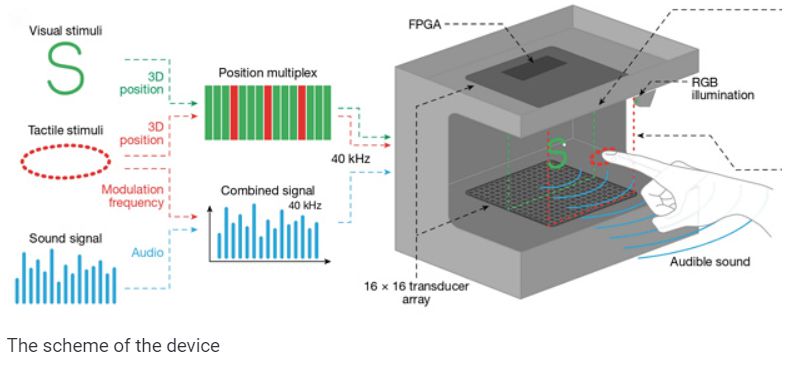British and Japanese engineers have created a 3D display based on acoustic levitation. It is responsible for the output of the image a small ball, moved through the work area by ultrasonic emitters, and illuminated by a high-speed projector. In addition, the device can reproduce sounds, as well as create a tactile response when the user brings a finger to the display.
Since science fiction often uses volumetric displays, the image of which is floating in the air, engineers have long been working on creating such technologies in real life. As a rule, surround screens work due to optical effects. For example, among such developments can be distinguished the Canadian screen of the light field for teleconferences and the American desktop 3D-screen, which works due to the lenticular raster.
However, such technologies create a volume effect inside the screen but do not give the impression that the image is hovering in the air. For this effect, engineers a few years ago proposed the use of acoustic levitation. It works because an array of ultrasonic emitters creates standing waves and stable areas with low and high pressure, capable of recording small objects, such as polystyrene balls. British engineers have already used this effect, fixing in the air an array of balls capable of turning the right colour to the observer or hanging a small a translucent piece of cloth on which the image is projected.
In a new paper, engineers led by Sriram Subramanian from the University of Sussex have created a screen in which one spherical particle is capable of creating in a real 3D colour image. The device is based on two arrays of ultrasonic emitters (16 by 16), located opposite each other: at the bottom and above the work area. An LED projector is also installed at the top of the side of the emitters array.

The principle of the display is based on the fact that the device quickly moves the area of low pressure, in which the polystyrene ball levitates, and illuminates it with colour, varying depending on the position of the ball in space. In the demo, you can see that the display allows you to display the toric knot visible in real-time and a butterfly flapping its wings. The video also shows more impressive examples, such as the levitating model of the Earth, however, these frames were shot at the much faster shutter speed and the person is unable to see them with the naked eye.
Experiments have shown that the display can accelerate the ball to a speed of 3.75 meters per second on a straight line and up to 0.75 meters per second when it draws the extreme and angular details in the image.
In addition to displaying three-dimensional images, the display is also capable of creating an audible sound for humans and producing a tactile response. To do this, the sound parameters on the emitters are adjusted in such a way that, in addition to the main trap used to levitate the ball, to form another area with a changed pressure on the side of it. By placing a finger in it, the user can feel the response of the screen.
The authors note that the characteristics of the image visible to the naked eye, including size, can be improved using a more accurate model of particle movement, as well as the more bright projector. In addition, a more accurate model will allow allocating a large share of the working cycle of emitters to the secondary trap, and thus strengthen the tactile response.
There is another technology to create a 3D image in the air, developed by Japanese engineers. They suggest using laser emitters that create glowing microdroplets of plasma in the air. By moving the glow region, the prototype of the device is able to create small volumetric figures directly in the air, and you can touch them with your finger.
